NEXT THING TO DO ON OUR LIST: :
Go UP the Lacerda Elevator to the Historical Centre of Salvador.
The Elevator takes 22 seconds to rise 72 meters. It can take 126 people at a time in 4 separate lifts. The queues are VERY long during peak hours, but they were not too long at 10h00 in the morning. Many Locals take the elevator to work. They estimate that 50 000 people use this elevator daily.
We paid the huge amount of 15 cents each for the ride : ).
LEFT: Lacerda from the bottom end.
ABOVE: We are inside the building, standing in line, waiting to go up. It was fun to watch the people. We saw very few tourists – mostly locals going shopping. The lines moved pretty quickly and we were soon counted into a lift. The whole procedure went very smoothly with ushers ushering and organising the lines.
LEFT: We had a lovely view from the top and it was a bright, sunny day.
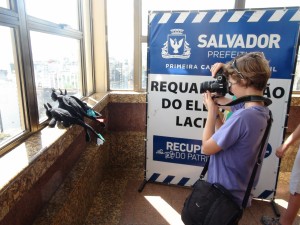 ABOVE: Before we left, each of my girls received a beautiful, handmade “Toothless” dragon from Bianca and Carla Van Harmelen.
ABOVE: Before we left, each of my girls received a beautiful, handmade “Toothless” dragon from Bianca and Carla Van Harmelen.
I can’t remember whose idea it was, but since Rio, we have photographed our little friends in many exotic places to prove that they are world-class travellers!
They usually hitch a ride with Karin J in her backpack and here Franci made sure that they will remember their exciting lift in the elevator!
LEFT :This tiny little woman (note that she is shorter than Sophia) came to show us her wares. We practically shouted out that we were tourists – what with our skin and hair colour and ….of course….., the camera.
LEFT: What you see when walking down the little streets in Salvador. The shop fronts are all this narrow and are crammed side by side. They sell many of the same things and we honestly do not know how they survive economically. The wooden sticks above Sophia’s head (that look a bit like bows for arrows) are musical instruments that you can pluck for a satisfactory sound.
It is very hard to know when we should actually buy something. We have very little money and soo many places to see – we couldn’t possibly get something from everywhere. But sometimes, after leaving a place, you think – I’ll never again have a chance to get one of those, maybe I should have bought it after all. Those musical thing-a-me-bobs are like that.
LEFT: All I could think of at this stage was, “Oh NOOOOO ! ! ! if we go ALL THE WAY DOWN there, we will have to come ALL THE WAY UP again! “.
At least this bit was in the shade. It is amazing how much more effort everything becomes because of the heat.
By the way, we DID go all the way down there and we HAD to come all the way back up – and – it wasn’t so bad in the end.
LEFT: Some more street stalls. It seems as if they really support the ANC over here. All the green and black and yellow!!
I know, I know, red is not an ANC colour, but it could have been?
Actually, it is the real Reggae influence you see everywhere.
LEFT: We saw some men practising Capoeira in one of the squares. Since we have no photos of real people, you get the street-art version.
Capoeira is a mix of dance and martial art where agile dancers move with unarmed combat techniques (I got this mouthful from the internet)
Salvador is said to be the centre of the origin of Capoeira. In 1892 the practice was actually banned, but in 1937 it was made legal again.
RIGHT :Many of these “wide”, colourful woman walk around the Historic Centre. They offer to pose with tourists (for a fee, of course). Why these specific outfits would be the traditional clothes of ANYONE living in such a hot country, I cannot imagine!
From what I could find, It seems to be the African influence adapting to the Catholic, missionary sensibilities that resulted in these hooped skirts and lace blouses with turban headdresses.
ABOVE: Palace Rio Blanco as seen from the bottom of the elevator. It is still in use today as an office for the Governor of Salvador, but has fallen into great neglect and according to the guide that took us around, will not last very long structurally.
LEFT: Our first visit to the Palace. Here we are in the museum on the ground floor. The rest of the Palace can only been seen with a booked tour and guide. We would not be able to tour the Palace until that Friday – as they had a Government wing-ding on and were using most of the halls.
RIGHT: We came back on the Friday, Karin J’s 13th Birthday. Here we are in the main entertaining hall. At the top of the doorway it is possible to see the gallery (reached by backstairs) where the musicians would be situated during a dance.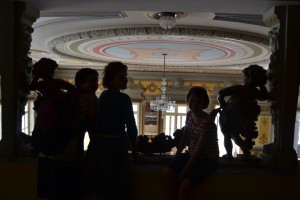
It is just possible to see our reflection in the mirror on the left.
LEFT: This photo shows Marike, Karin J and Sophia on the musicians gallery, looking down into the hall. Three of my angels next to the little cherubic angel statues.
BELOW: Sophia and Karin J on the balcony of the Rio Blanco Palace. It is possible to see Shang Du parked at the Marina.
LEFT: The same balcony, but from a different angle. Here it is easy to see the neglect.
When we first entered Salvador, it looked as if the buildings had been damaged by fire. At closer inspection we realised that it is just black mould – caused by the high humidity – Yuck!!!
Buildings in Brazil have to be painted on a very regular basis to retain their looks.
We tried to enter the churches in the Historic Centre, but found them all closed. It was only when we eventually found a tourist information office, that we were told that they only open at 14:00. Whether it was only that day or if this is true for other days too, we do not know.
We were happy to be able to see the Convent and Church of São Francisco as it was highly praised in the guide books.
LEFT: We started admiring the artwork made up of blue-and-white painted tiles that run along the courtyard walls. As we were doing this, we suddenly acquired a guide (not sure where he came from) and he helped explain the meaning of each picture. They all depict a sin or action that believers should avoid. Most people could not read and this was a way to teach them correct conduct.
A little of the advice comes from of the Bible, but there is a lot of Mythology, Paganism and Philosophy thrown in too. One of the Pearls of wisdom were: “It is better to have a dog for a friend, than a friend who acts like a dog.”
LEFT: Before we could transition from the Monastery to the Church, our guide made us keep our eyes downcast and then he led us to stand in a specific spot. Only then were we allowed to open our eyes. WOW !!! So much gold all at once! So many details and intricacies in this one room! It was really quite overwhelming.
There was a lot of “Politics” involved in the building of this church. This was true of the whole Catholic church system (probably still is). Anyway, the people doing the work – most likely slaves – did not feel they were treated fairly and used a number of interesting ways to get back at their superiors.
RIGHT: This depiction of the apostle Peter was purposefully made to make him look very ill. From one side he has a healthy looking colour, but on the other side, they painted him a sickly hue.
There also are a lot of African icons hidden in the walls and quite a few of the angels look decidedly pregnant! I don’t know if we would have seen all this without the help of our guide.
LEFT: Franci with some more of the magnificent gold leaf work.
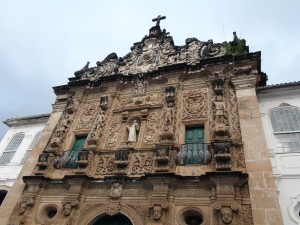 LEFT: This façade of the Igreja da Ordem Terceira de Sao Francisco, right next door to the previous church, was miraculously preserved. Somewhere in eighteenth century it was covered with mortar and forgot about. Since that time the rest of the church underwent a facelift (read boring modern buildings), but, fortunately for us, this part could not be re-done as the funds had dried up.
LEFT: This façade of the Igreja da Ordem Terceira de Sao Francisco, right next door to the previous church, was miraculously preserved. Somewhere in eighteenth century it was covered with mortar and forgot about. Since that time the rest of the church underwent a facelift (read boring modern buildings), but, fortunately for us, this part could not be re-done as the funds had dried up.
Years later, in the early twentieth century, during services in the electric grid, it was rediscovered. It wasn’t seen until a workman installing wiring in the 1930s serendipitously discovered the beautiful, baroque sandstone façade (the only one of its kind in Brazil).
LEFT: We chose NOT to have our picture taken with one of the fancy dressed-up Bahian woman. They were quite aggressive in their marketing and I found them a bit scary.
However, we jumped at the chance to play dress-up with this vendor. She had her photo-opportunity set up with the San Franciscan church in the background. The only drawback was that the sun shone directly in our eyes. Frans had the advantage of sunglasses, but I just managed to pull my face.
RIGHT: This is the way the dress-up works. We had to stand behind the clothes and wear the headdresses. Very clever!
BELOW: Frans in his Rasta Man pose!
LEFT: Marike getting ready. A good touch is to hang the beads around the person’s neck and then let it hang in front of the “dress”
BELOW: Sophia looking smug (good way to keep the sun out of your eyes).
ABOVE: Franci is devastated by the way her food turned out.
LEFT: Karin J didn’t want to have anything to do with this dressing up thing until we allowed her to go as Rasta Man the Second.
She is actually standing on the boards visible through the legs of the pants
RIGHT: Coconut milk for the children (and the Mom).
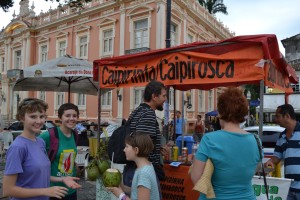 BELOW: Frans trying the National drink: Caparinha (Pronounced Cape-ee-ring-ja).
BELOW: Frans trying the National drink: Caparinha (Pronounced Cape-ee-ring-ja).
They mix it on the spot with fresh lime juice, sugar and a “squirt” of the Sugarcane Liquor Cachaça. To the right of the picture is our Taxi driver of the previous day. He wanted to overcharge us majorly, but Frans negotiated until he brought the price down. He still overcharged though. Then he found out we were a family of sailors. He didn’t change the price, but dropped us RIGHT in front of the marina, being very friendly all the time..
He was pleased to see us again and enjoyed Frans’ experience of watching the drink being made. The lady had no measurement for the liquor and seemed to be tipping in quite a bit.
BELOW: Back at the boat, we visited some with the lovely family sailing on “Outer Rim”. He is German and his wife Natalie is from Russia. They have four children. It is from them that we learned that a child under the age of 2 does not feel seasick at all.
LEFT: This monument is one of the other more “modern” things to see in the area below the elevator.
Such a weird shape! It is telling that I thought it reminded me of some womanly curves, but that Frans thought it resembled something more manly. LOL
Our guide to the Blanco Palace told us that it was a monument to Dengue – that dreaded debilitating viral disease of the tropics, transmitted by mosquitoes, and causing sudden fever and acute pains in the joints.
We thought that he meant the statue was in aid of the FIGHT AGAINST Dengue until he explained that it is the mosquito invested water around the base that he is referring to.
 RIGHT: Frans and I ready to go exploring in Old Town.
RIGHT: Frans and I ready to go exploring in Old Town.
Note the camera bag on Frans’ chest. This is the normal position for it and he often has another pack on his back.
I am carrying an umbrella. Here in the tropics it can start raining at any time.
the cup in my hand was full of some lovely fruit salad that we bought from a street vendor with a little cart. They sell the fruit salad in different sized containers, with a choice of condense milk or any of variety of flavoured syrups as toppings. Needless to say, I refrained from adulterating my fruit salad with those.
LEFT: The Church of Nosso Senhor do Bonfim. is one of the most popular pilgrimage sites in all of Brazil
The men in the foreground walk around with weird things in bowls ready to confer a blessing for some payment.
There were also women or children everywhere in Salvador that wanted to tie little colourful ribbons round our wrists. They kept on saying: “for gift, for gift”, but later we found out how this works.
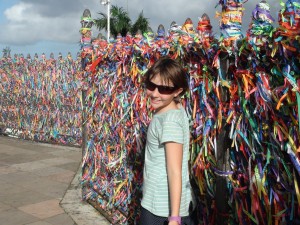 RIGHT: The colorful votive ribbons or fitas of Bonfim can be seen here, tied to the railings in front of the church. Each of these represents a wish or petition.
RIGHT: The colorful votive ribbons or fitas of Bonfim can be seen here, tied to the railings in front of the church. Each of these represents a wish or petition.
Children outside the church will (for a small fee) tie them around your wrist and tell you to make a wish for each one. (Our lack of Portuguese meant that we could not understand what they were doing). If the ribbon wears off naturally, the wish will come true; if you cut it off before then, it won’t. There is even the implied threat that you might incur a curse upon yourself if you remove it.
LEFT: The interior of the church – Main Hall
BELOW: There were sooo many places in this church to “donate” money in return for a “blessing” or healing or any other answer to prayer.
This room was filled with replicas of limbs as well as many, many photos of people on the walls for whom paid petitions have been made.
There was also the usual Roman Catholic practise of buying a candle to burn in aid of a prayer petition.
Bahia syncretism, in which rituals of Afro-Brazilian blend with Catholic traditions are practised here.
Since slaves were forbidden from engaging in candomblé rites, they masked them as Catholic observances and associating their deities with Catholic counterparts.
Bom Jesus do Bonfim corresponds to Oxalá – an orixá, or candomblé deity, strongly associated with the creation of the world and a peaceful ending to life, filled with accomplishment – a good ending, or bom fim.
For us, this seemed a very sad place with a lot of rituals practised in fea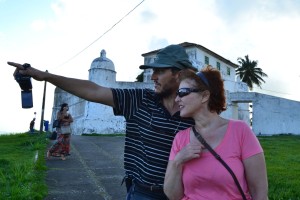 r and bondage, with someone obviously gaining financially.
r and bondage, with someone obviously gaining financially.
RIGHT: Forte Monte Serrat.
The taxi driver that took us to the Bonfim Church, out of his own initiative, added the Monte Serrat Fort into the deal. We had to fight the traffic back anyway.
It was well worth the visit.
LEFT: It is a good thing for Karin J and Marike that this couldn’t be fired at any moment.
BELOW: One of the shooting holes of the fort, from which the defenders could aim at their assailants.
It is much wider towards the inside to be able to angle your gun in any direction.
The next three photographs show the use of tiles in Brazilian architecture. This is especially true of Old Town in Salvador. The first two are old residences, while the last one is converted into a diving shop. Note the use of rolling down garage-type doors to close up the shop.
.
BELOW: This is how we get back on board Shang Du.
The tide and the wind determine how big the gap will be. The agility of the person determines how long they need to wait.
BELOW: Notice how I am the one waiting 🙂
Alas, we needed to move on.
We have not by any means exhausted all there is to see in Salvador.
The Indo-American Museum was closed due to a strike and the large Rosino Cathedral was closed due to renovations (we did have a sneak-view past some scaffolding).
We are always sad when we leave a place, knowing that we will most likely never return. But……. and this is a big but…………………
We will always be grateful for every single thing that we were able to see and do.

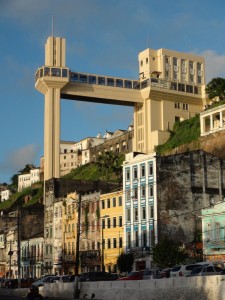
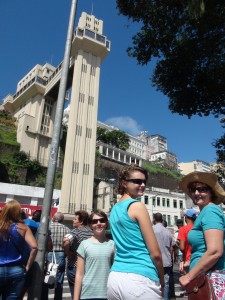
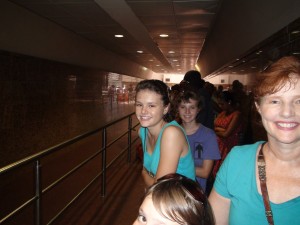
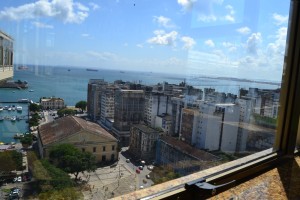
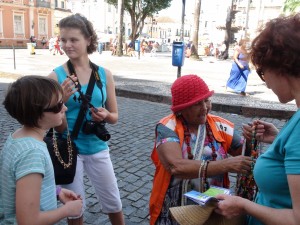
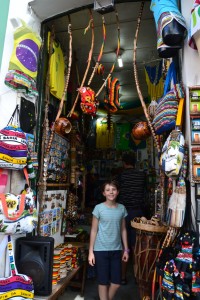
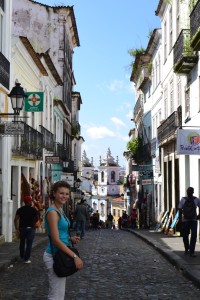
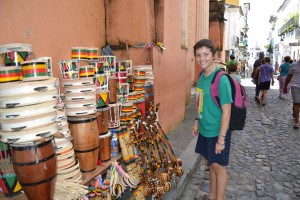
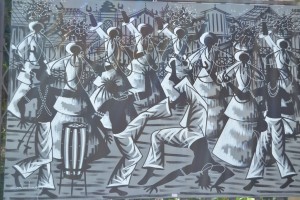
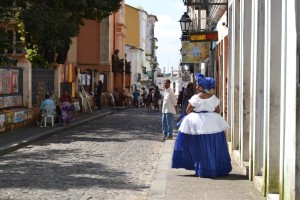
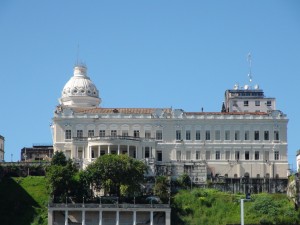
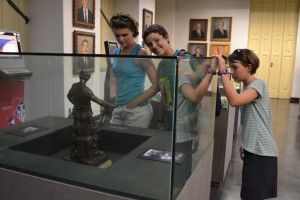
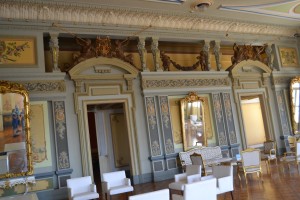
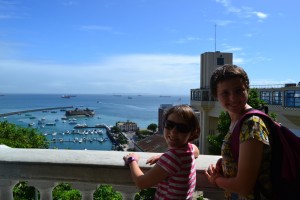
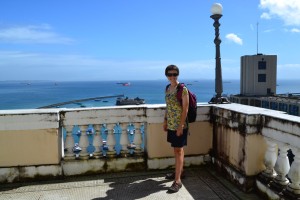
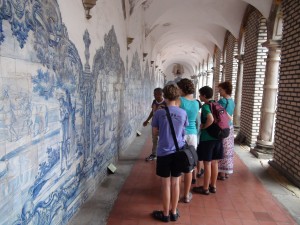
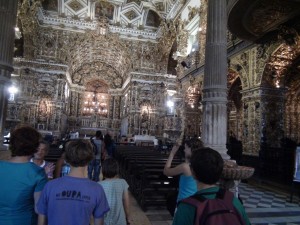
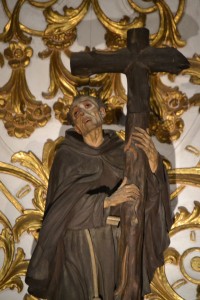
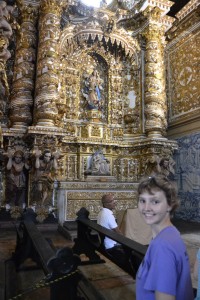
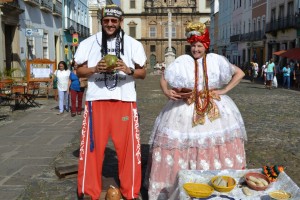
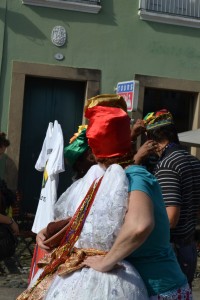
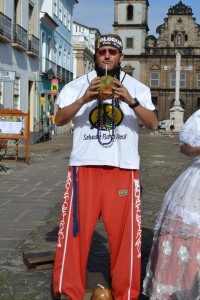
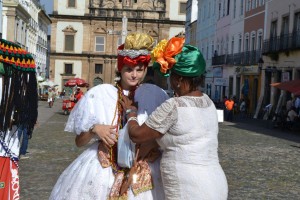
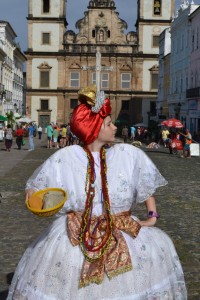
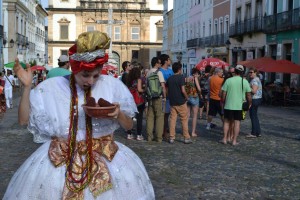
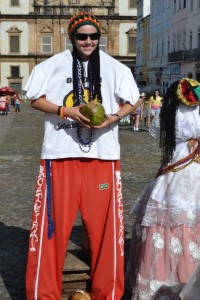
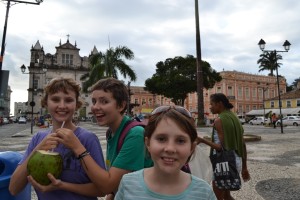
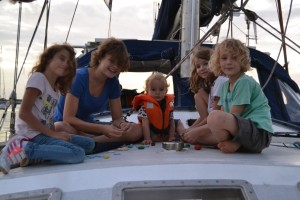
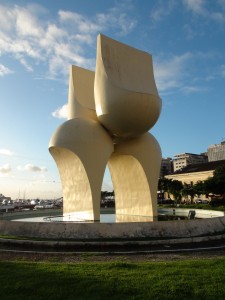
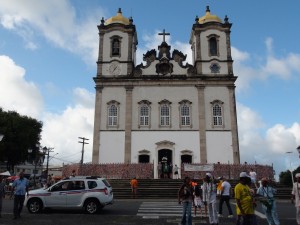
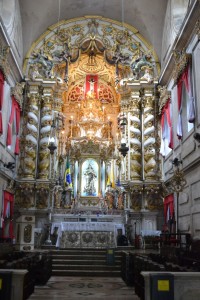
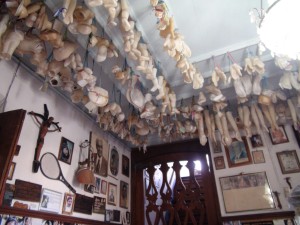
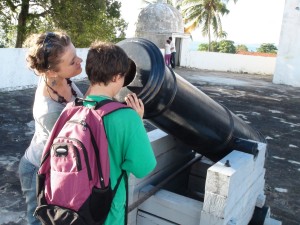
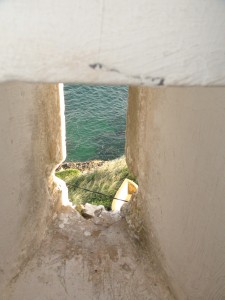
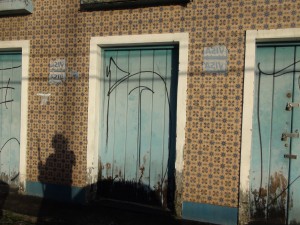
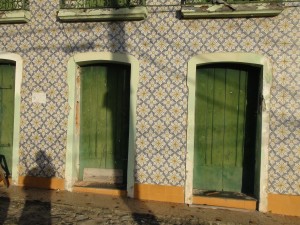
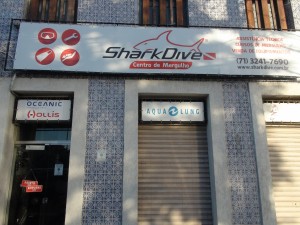
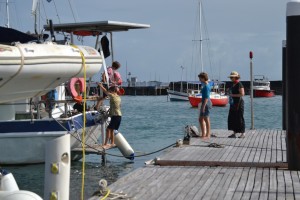
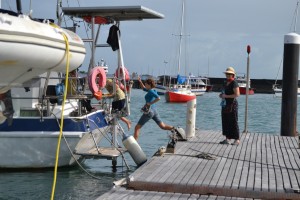
2 comments
Love die teëls!
Fantastic news of your visit. Love all the info you give us! Very interesting! It is hard to travel and not buy anything. I bought charms for a bracelet when travelling Europe (one from each country) and also bought an umbrella in London because I needed one – and I still have it! I was wearing a shirt with “newsprint” on it and while looking for an umbrella the vendor kept insisting all the umbrellas were sold except for one and he dug out a brolly with “newsprint” on!! I love it and the memory of that day! So treat yourself occasionally to something local and practical!!
Love your news keep it up! Love from us xxxxxx